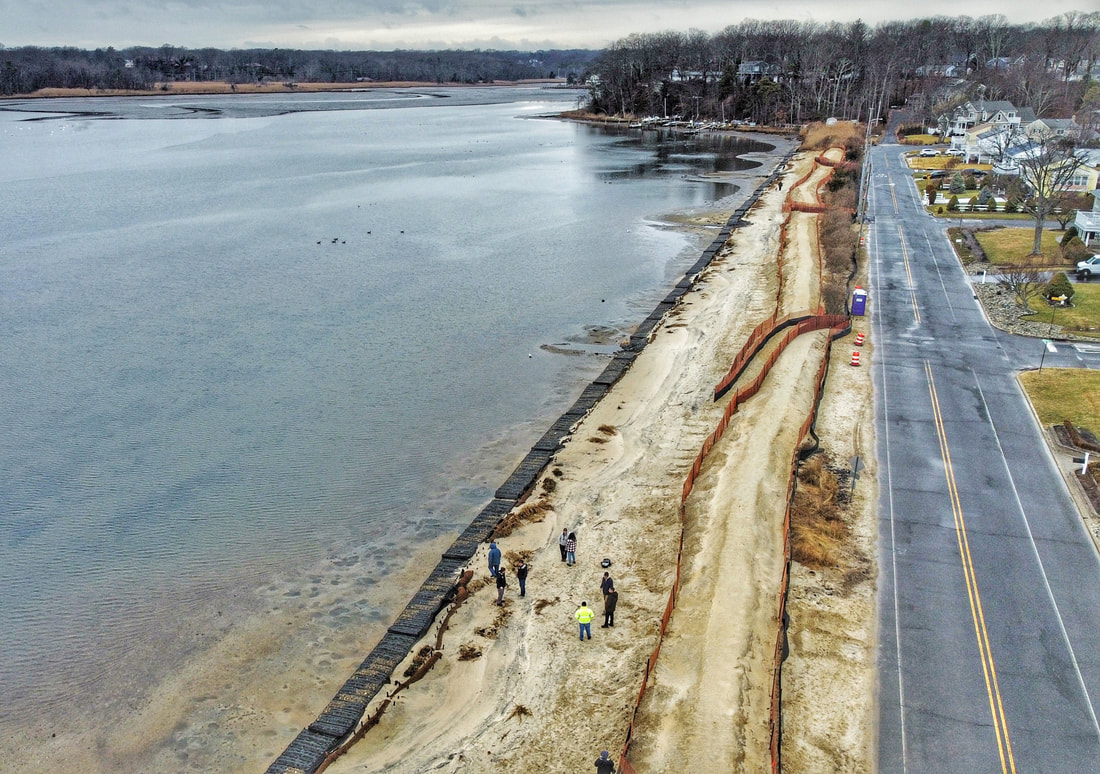|
With winter coming to a close, it's a good time for an update on the Littoral Society's current restoration work and upcoming opportunities for you to help. We have projects underway on South Riverside Drive in Neptune, NJ; Slade Dale Sanctuary in Point Pleasant, NJ; Forked River Beach in Lacey Township, NJ; and the Mouth of the Maurice River near Bivalve, NJ. The Society’s restoration work was also recognized through New Jersey's 23rd Annual Governor’s Environmental Excellence Awards and as one of the initial recipients of a New Jersey Natural Climate Solutions. First, let’s look at our project on South Riverside Drive in the Shark River Hills section of Neptune Township, which has a stakeholders meeting scheduled for Wednesday, March 1 at 7 p.m. 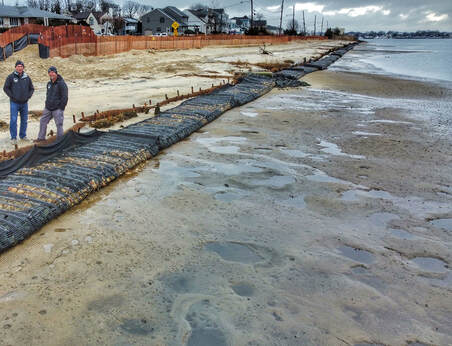 Tensar "mattresses" - black, mesh polymer bags filled with stone and shell - help stabilize the shoreline at the South Riverside Drive project. Tensar "mattresses" - black, mesh polymer bags filled with stone and shell - help stabilize the shoreline at the South Riverside Drive project. South Riverside Drive Late in 2022, work began to restore and protect a section of eroding beach and wetlands along the Shark River by building a living shoreline that would help protect the surrounding community from storms and waves, while also creating habitat for wildlife. Residents of the neighborhood had opposed prior project designs that focused on “harder” solutions, such as a bulkhead or stone revetment. Those designs would have provided flood protection but at the expense of habitat. The living shoreline approach uses dunes and wetlands to help protect the community while also creating habitat and cleaner water. Initial work, which was largely completed by February, included placement of special "mattresses" and coir logs to stabilize the shoreline, while also raising the beach and building a dune to provide added resiliency during storm or high-tide events. The mattresses are large, mesh polymer bags that are filled with rock and shell that have been placed in the Shark River just beyond a dilapidated wooden bulkhead. The logs, which are made from coconut husks, were used to line nearly 2,000 feet of shoreline. Both mattresses and logs aim to reduce erosion caused by waves and tides and preserve the tons of sand used to rebuild the beach and dune. You can lend a hand with this project by joining us on March 25 for a dune planting event at the site. The work will take place from 11 a.m. - 3 p.m. Find more information on the registration page. We will be planting 15,000 culms of dune grass, which will help anchor the dune in place. Work gloves and dibble sticks will be provided. Dress to get dirty; the event is rain or shine. Once the restoration aspect of the work is completed, the Littoral Society - with the help of interested community members - will continue to monitor the project for five years. Stay tuned for how you can join our monitoring program. 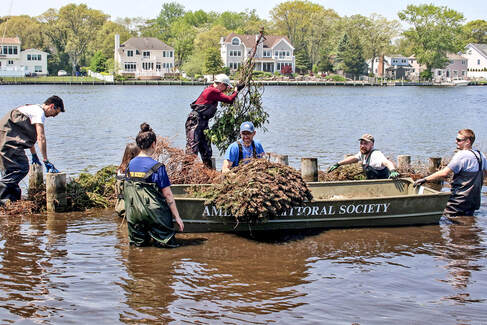 Slade Dale Nature Preserve Christmas trees continue to be the gift that keeps on giving to our ongoing Slade Dale Nature Preserve restoration project in Point Pleasant, NJ. For the third year, Point Pleasant Borough's Department of Public Works has collected residents' natural trees that were left for curbside collection. The Borough's Good Shepherd Lutheran Church also hosted a drop-off site for the public through the end of January. Other trees came via Lacey Township and the Brielle Environmental Commission. The trees will be used in an ongoing living shoreline project at the Slade Dale Sanctuary, a 13-acre municipal property on Sea Point Drive. In the spring, trees that have been collected will be put into branchbox breakwaters, which are wooden structures set in Beaverdam Creek. The breakwaters are designed to control erosion by using trees and brush to slow currents and waves, as well as capture the sediment being carried in the water. The shoreline at the Slade Dale Sanctuary has eroded about 300 feet since 1930, jeopardizing the sanctuary’s pine-oak forest, hardwood swamp, and salt marsh. The sanctuary was created to provide a space of protected wilderness that would provide nursery habitat for fish, as well as foraging habitat for ospreys, egrets, and bald eagles. Living shorelines use natural materials such as plants, sand, or rock to stabilize the shoreline, reduce erosion, and provide valuable habitat. They also tend to be far less expensive to construct and maintain than hard structures. The bonus is that living shorelines grow over time. Because they are designed as a natural solution, the trees in the breakwaters must be replaced periodically. 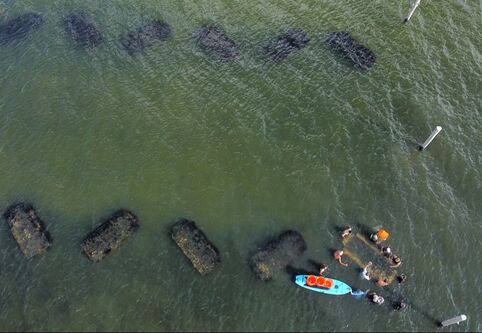 Forked River Beach Forked River Beach, in Lacey Township, NJ, is one place where the disappearance of oysters - and the reefs they build - has hit home, as high tides now bring bay water into some nearby residences. The site has lost over a hundred and fifty feet of shoreline since 1995 and erosion there has been accelerating since Superstorm Sandy in 2012. In 2021, a coalition led by the Littoral Society began work to restore Forked River Beach by constructing reefs using large wire baskets called HESCOs. Those baskets will eventually become home to full grown oysters that will help to stabilize the shoreline and clean surrounding waters. Late last year the reefs were seeded with more than 32 million oyster larvae, which will attach to the shell in the HESCOs. 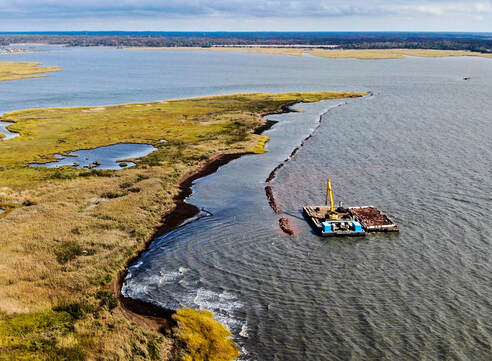 Mouth of the Maurice The towns, oyster fleet docks, and marshes surrounding the Maurice River are among the most vulnerable areas within the Delaware Bay, largely due to the disappearance of wetlands at the estuary's mouth. Since 1985, the marshlands of Basket Flats - a peninsula of salt marsh that extends from the river mouth’s western shore - have lost over a quarter mile, exposing upstream areas - including the towns of Shellpile and Port Norris - to increased threats from storms and tides. The first priority is the critically eroded Basket Flats, a peninsula of salt marsh that extends from the mouth’s western shore and protects the oyster docks at Bivalve and Matts Landing from the waves and currents of the open bay. Since 1985, Basket Flats has been winnowed by over a quarter mile, virtually eliminating an entire reach — or bend — in the river. The erasure of Basket Flats has also caused an increase in the amount and frequency of wave energy hitting Northwest Reach, on the opposite shore, resulting in a half-mile-wide swath of shallow, open water where there were once healthy tidal wetlands. To build back the marsh and prevent future erosion, the Society - in concert with the Wildlife Restoration Partnership, Stockton University, Mount Construction Company, the National Fish and Wildlife Foundation, US Fish & Wildlife Service and NJ Department of Environmental Protection - has undertaken the biggest nature-based shoreline restoration project in the Garden State right now. Initial steps in the project involved creation of 600-foot wall and installation of hybrid living shoreline breakwaters. Building breakwaters and oyster reefs to reduce the force of waves on the shoreline, prevent further marsh loss, and encourage marsh growth. Eventually, the work will extend to Northwest Reach on the other side of the river from Basket Flats. Once complete, this restoration will protect several communities upriver - including Bivalve, Shellpile and Port Norris - while also providing improved habitat for fish, crabs, and birds. “We are protecting both the communities and local economies of Delaware Bay and its ecology with this project,” said Tim Dillingham, Executive Director of the Littoral Society. “These projects, because they are larger in scale, will give us a chance to prove that it can be done, and that it can be done collaboratively.” Natural Climate Solutions Grant In January, the Littoral Society was named one of the initial recipients of a New Jersey grant program designed to fund projects that use nature-based techniques to combat the effects of climate change. The nearly $5 million allocation from the new Natural Climate Solutions Grant Program will help fund our work to restore marshlands at the mouth of the Maurice River. This innovative program, one of the first of its kind in the nation, is providing $24.3 million to projects that help mitigate climate change by creating, restoring, and enhancing New Jersey’s green spaces and tree canopies in urban areas, as well as natural carbon sinks, such as salt marshes, seagrass beds, forests, and parks. The funding comes through New Jersey’s participation in the Regional Greenhouse Gas Initiative (RGGI), a multi-state, market-based program that establishes a regional cap on carbon dioxide emissions from fossil fuel power plants. The RGGI provides New Jersey with auction proceeds to invest in programs and projects designed to help meet its climate, clean energy, and equity goals. Natural resources that sequester carbon play a critical role in meeting the State’s 2050 goal of an 80% reduction in greenhouse gases below 2006 levels. 23rd Annual Governor’s Environmental Excellence Award
Just before Christmas, the Society was recognized as one of the winners of New Jersey's 23rd Annual Governor’s Environmental Excellence Awards. The Society was honored for work on Healthy Ecosystems and Habitats, specifically for constructing oyster reefs to help improve the resiliency of beaches and shorelines. As noted in the award announcement from NJ Department of Environmental Protection (NJDEP) Commissioner Shawn M. LaTourette, the oyster reefs provide multiple benefits to the ecology such as new habitat, improved water quality, and an area that promotes re-establishment of submerged aquatic vegetation. In addition to reef construction, the work includes post-restoration monitoring and a community science program, seeding reefs with live oysters, and the use of recycled shell from local restaurants for constructing the reefs. The Littoral Society has been building oyster reefs along Delaware Bay and Barnegat Bay beaches since shortly after Hurricane Sandy in 2012. The Society also runs the "Shuck It, Don't Chuck It!" shell-recycling program, which collects shells from restaurants in Monmouth County for eventual use as part of reef and living shoreline projects. Learn more about this restoration work through our website. The Society was recognized along with 10 other organizations and individuals that demonstrated commitment and leadership on a variety of environmental issues, including environmental justice, climate change, sustainability, education, and protection of natural resources. Comments are closed.
|
Archives
July 2024
Categories
All
|

